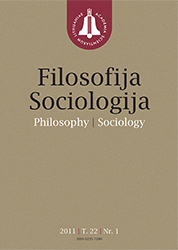Activity and Passivity in the Creation of Art: Heidegger and Later Philosophers
Activity and Passivity in the Creation of Art: Heidegger and Later Philosophers
Author(s): Rūta Marija VabalaitėSubject(s): Aesthetics, Contemporary Philosophy, Sociology of Culture, Sociology of Art
Published by: Lietuvos mokslų akademijos leidykla
Keywords: Passivity; artist; value; artwork; creation;
Summary/Abstract: The article deals with the consideration that in spite of the fact that artistic creation is firstly an active work, the artist sometimes is not the only determinant factor of the value of the artwork, therefore some senses of the work that have not been predicted or consciously embodied by the artist might emerge. Creative inspiration, which creates the conditions for the appearance of something unpredicted, has been usually explained as the highest form of the creativity of the artist. We reconstruct Heidegger’s innovative thought about the creativity as a partly passive attitude of the artist in the first chapter of the article. The second part deals with the development of the ideas of creation as a specific form of inactivity of the artist in the works of Hans-Georg Gadamer, Maurice Merleau-Ponty, Theodor Adorno and later French philosophers Gilles Deleuze, Felix Guattari, and Alain Badiou. We look into their concepts that are formulated on purpose to explain the possibilities of the artistic creation, which might interrupt the standardized, stereotypical life, to promote the appearance of something unplanned and unforeseen.
Journal: Filosofija. Sociologija
- Issue Year: 2017
- Issue No: 1
- Page Range: 3-10
- Page Count: 8
- Language: English

